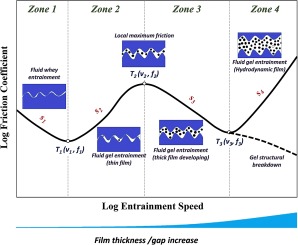当前位置:
X-MOL 学术
›
Food Hydrocoll.
›
论文详情
Our official English website, www.x-mol.net, welcomes your
feedback! (Note: you will need to create a separate account there.)
Effect of different hydrocolloids on texture, rheology, tribology and sensory perception of texture and mouthfeel of low-fat pot-set yoghurt
Food Hydrocolloids ( IF 11.0 ) Pub Date : 2017-06-06 10:09:29 Phuong T.M. Nguyen, Olena Kravchuk, Bhesh Bhandari, Sangeeta Prakash
Food Hydrocolloids ( IF 11.0 ) Pub Date : 2017-06-06 10:09:29 Phuong T.M. Nguyen, Olena Kravchuk, Bhesh Bhandari, Sangeeta Prakash

|
A systematic study on the effect of some commonly used hydrocolloids in yoghurt formulation, namely gelatin (0.5–1.5%), xanthan gum (0.005–0.015%), carrageenan (0.01–0.08%) and modified starch (0.5–1.5%) on the physical, tribology and sensory characteristics of skim pot-set yoghurt (0.1% fat) is presented. The results support to develop a tribology model for yoghurt, which can be directly correlated with the scores on texture and mouthfeel attributes from sensory panel by mean of statistical analysis. The tribological behavior, which signifies the lubrication property of the product, depended on the fat content, the type and dosage of hydrocolloid. Among the four hydrocolloids investigated, gelatin appeared to be the best hydrocolloid due to its ability to reduce syneresis, increase texture, viscosity, gel strength and lubrication properties of skim yoghurt. As a result, its sensory perception was significantly improved and attained the same sensory scores with full fat yoghurt for various desired sensory attributes, such as thickness, smoothness and creaminess. Both xanthan gum and carrageenan increased the firmness and viscosity of skim yoghurt, but also significantly increased the syneresis and undesired sensory mouthfeel characteristics, such as chalkiness and lumpiness. Modified starch slightly improved lubrication properties and thickness of skim yoghurt without significant changes in the product texture. From tribological analysis of investigated samples, a four-zone tribology model for yoghurt was proposed. Each zone corresponds to different mechanisms of fluid entrained between the two contact surfaces. The tribology behavior of the yoghurt fluid, therefore, can be represented by the position of each transition point and the slope of each friction zone, which were aligned with the sensory scores from trained panel.
中文翻译:

不同水胶体对低脂锅装酸奶质地,流变学,摩擦学和质感和口感的感觉的影响
对酸奶中一些常用的水胶体(明胶(0.5–1.5%),黄原胶(0.005–0.015%),角叉菜胶(0.01–0.08%)和改性淀粉(0.5–1.5%))的影响进行了系统的研究。介绍了脱脂酸奶(0.1%脂肪)的物理,摩擦学和感官特性。结果支持开发酸奶的摩擦学模型,该模型可以通过统计分析与感官小组的质地和口感属性得分直接相关。表示产品润滑性能的摩擦学性能取决于脂肪含量,亲水胶体的类型和用量。在所研究的四种水胶体中,明胶由于其减少脱水收缩,增加质地,粘度,脱脂酸奶的凝胶强度和润滑性能。结果,对于各种所需的感官属性,例如厚度,光滑度和乳脂状,其感官知觉得到了显着改善,并且在全脂酸奶中获得了相同的感官评分。黄原胶和角叉菜胶均增加了脱脂酸奶的硬度和粘度,但也显着增加了脱水收缩和不希望的感觉口感特性,例如白垩度和块状。改性淀粉可略微改善润滑性能和脱脂酸奶的厚度,而不会明显改变产品质地。通过对被调查样品的摩擦学分析,提出了酸奶的四区域摩擦学模型。每个区域对应于在两个接触表面之间夹带的流体的不同机制。
更新日期:2017-06-07
中文翻译:

不同水胶体对低脂锅装酸奶质地,流变学,摩擦学和质感和口感的感觉的影响
对酸奶中一些常用的水胶体(明胶(0.5–1.5%),黄原胶(0.005–0.015%),角叉菜胶(0.01–0.08%)和改性淀粉(0.5–1.5%))的影响进行了系统的研究。介绍了脱脂酸奶(0.1%脂肪)的物理,摩擦学和感官特性。结果支持开发酸奶的摩擦学模型,该模型可以通过统计分析与感官小组的质地和口感属性得分直接相关。表示产品润滑性能的摩擦学性能取决于脂肪含量,亲水胶体的类型和用量。在所研究的四种水胶体中,明胶由于其减少脱水收缩,增加质地,粘度,脱脂酸奶的凝胶强度和润滑性能。结果,对于各种所需的感官属性,例如厚度,光滑度和乳脂状,其感官知觉得到了显着改善,并且在全脂酸奶中获得了相同的感官评分。黄原胶和角叉菜胶均增加了脱脂酸奶的硬度和粘度,但也显着增加了脱水收缩和不希望的感觉口感特性,例如白垩度和块状。改性淀粉可略微改善润滑性能和脱脂酸奶的厚度,而不会明显改变产品质地。通过对被调查样品的摩擦学分析,提出了酸奶的四区域摩擦学模型。每个区域对应于在两个接触表面之间夹带的流体的不同机制。































 京公网安备 11010802027423号
京公网安备 11010802027423号